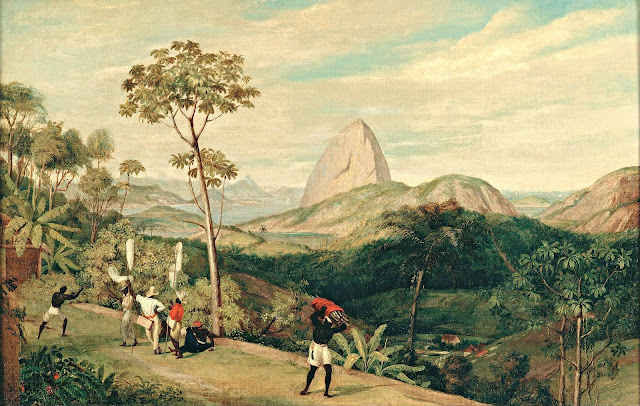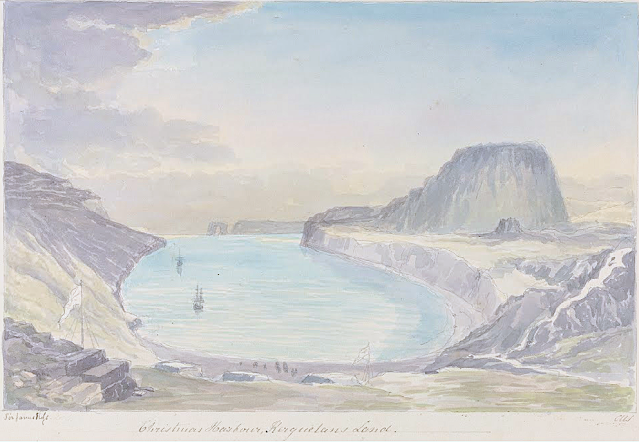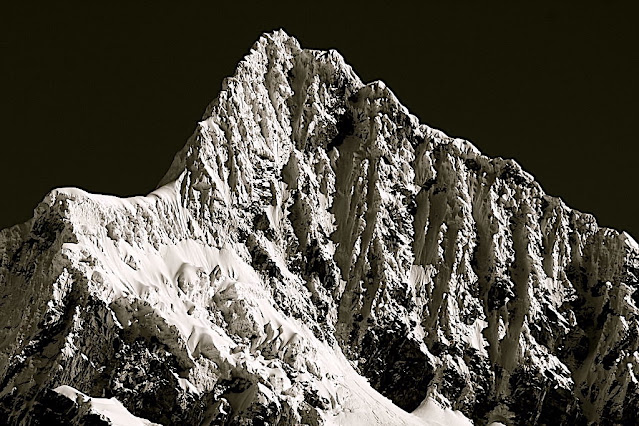EDWARD LEAR (1812-1888)
Mount Sinaï / Jabal Musa (2,285 m - 7,496ft)
Egypt
In View of Mount Sinai, Watercolor,with some white tempera, over pencil, on cream-colored wove paper.
(178 x 376 mm) Purchased as the gift of Mrs. Vincent Astor, The Morgan Library & Museum
The mountain Mount Sinaï (2,285 m - 7,496ft) or Jabal Mūsā or Gabal Mūsā (in arab : "Moses' Mountain" or "Mount Moses"), also known as Mount Horeb or Jebel Musa (a similarly named mountain in Morocco), is a mountain in the Sinai Peninsula of Egypt that is a possible location of the biblical Mount Sinaï.
The latter is mentioned many times in the Book of Exodus (and other books of the Bible) and in the Quran. According to Jewish, Christian, and Islamic tradition, the biblical Mount Sinai was the place where Moses received the Ten Commandments (depicted in the Jean-Léon Gérôme painting above).
Mount Sinai is a moderately high mountain near the city of Saint Katherine in the Sinai region. It is next to Mount Katherine (2,629m - 8,625 ft), the highest peak in Egypt.
Mount Sinai's rocks were formed in the late stage of the Arabian-Nubian Shield's (ANS) evolution. Mount Sinai displays a ring complex that consists of alkaline granites intruded into diverse rock types, including volcanics. The granites range in composition from syenogranite to alkali feldspar granite. The volcanic rocks are alkaline to peralkaline and they are represented by subaerial flows and eruptions and subvolcanic porphyry. Generally, the nature of the exposed rocks in Mount Sinai indicates that they originated from differing depths.
There are two principal routes to the summit. The longer and shallower route, Siket El Bashait, takes about 2.5 hours on foot, though camels can be used. The steeper, more direct route (Siket Sayidna Musa) is up the 3,750 "steps of penitence" in the ravine behind the monastery.
The summit of the mountain has a mosque that is still used by Muslims. It also has a Greek Orthodox chapel, constructed in 1934 on the ruins of a 16th-century church, that is not open to the public. The chapel encloses the rock which is considered to be the source for the biblical Tablets of Stone. At the summit also is "Moses' cave", where Moses was said to have waited to receive the Ten Commandments
The painter Edward Lear was an English artist, illustrator, musician, author and poet, and is known now mostly for his literary nonsense in poetry and prose and especially his limericks, a form he popularised. His principal areas of work as an artist were threefold: as a draughtsman employed to illustrate birds and animals; making coloured drawings during his journeys, which he reworked later, sometimes as plates for his travel books; as a (minor) illustrator of Alfred Tennyson's poems. As an author, he is known principally for his popular nonsense collections of poems, songs, short stories, botanical drawings, recipes, and alphabets. He also composed and published twelve musical settings of Tennyson's poetry.
Lear was already drawing "for bread and cheese" by the time he was aged 16.
In 1842, Lear began a journey into the Italian peninsula, travelling through the Lazio, Rome, Abruzzo, Molise, Apulia, Calabria, and Sicily. In personal notes, together with drawings, Lear gathered his impressions on the Italian way of life, folk traditions, and the beauty of the ancient monuments. Of particular interest in Lear was the Abruzzo, which he visited in 1843, through the Marsica (Celano, Avezzano, Alba Fucens, Trasacco) and the plateau of Cinque Miglia (Castel di Sangro and Alfedena), by an old sheep track of the shepherds.
Among his travels, he visited Greece and Egypt during 1848-49, and toured India and Ceylon during 1873–75. While travelling he produced large quantities of coloured wash drawings in a distinctive style, which he converted later in his studio into oil and watercolour paintings, as well as prints for his books. His landscape style often shows views with strong sunlight, with intense contrasts of colour. Between 1878 and 1883 Lear spent his summers on Monte Generoso, a mountain on the border between the Swiss canton of Ticino and the Italian region of Lombardy. His watercolor Mount Olympus dated 1849 in in the MET in New York City. His oil painting The Plains of Lombardy from Monte Generoso is in the Ashmolean Museum Oxford (UK).
_______________________________
2022 - Wandering Vertexes...
by Francis Rousseau
-%20K2%20%20in%201909.jpg)
-mucculla-in-abyssinia%20%20(Ethiopia)Handcolored%20aquatints%201809.king%20Geroge%20III%20topographical%20collection%20.jpeg)
%20-%20Mount%20Fuji,.jpg)

,%201885%E2%80%931886-%20Barnes%20Foundation.jpg)

%20acrylic-on-canvas.%20(2.1%20m%20%C3%97%203.0%20m)-%20Chez%20Tony%20Richardson%20%20Le%20Nid%20du%20Duc%20les%20collines%20des%20Maures%20de%20La%20Garde-Freinet%20%20.jpg)
-%20'Kilauea'.jpg)
-%20vue%20de%20NAplouse%20et%20du%20Mont%20Ebal%20%20_Hallwylska_museet.jpg)




%20-%20Atlas-mountains-Oukaimeden%20the-view-from-Marrakesh-1949.jpg)
%20%20-%20Leo%20Wehrli%20et%20Carlos%20Bruckdevant%20le%20%20%20Volcan%20Planchon%20(1897),%20Colorie%CC%81%20par%20Anna%20M.%20Wehrli-Frey-%09%20ETH%20Library%20%20Zurich%20%20.jpg)

%20grayday-%20Green%20land%20Iceberg%20Alaska%20%20.jpg)